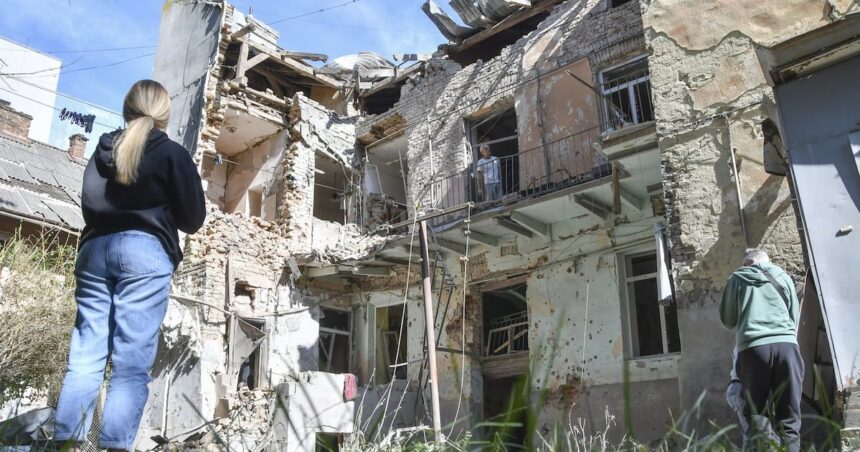Article – Explosions shattered the night in Kyiv’s residential district of Sviatoshyn last Tuesday, when Russian cruise missiles struck an apartment complex where Nadia, a 34-year-old schoolteacher, was preparing for bed. “The windows blew in first, then the ceiling started to collapse,” she told me by phone yesterday, her voice still shaking. “My neighbor died while sleeping. He was 67 years old and survived two years of this war only to be killed in his own bed.”
The overnight barrage killed at least two civilians and injured dozens more across Ukraine, part of an intensifying aerial campaign that Ukrainian officials describe as deliberately targeting civilian infrastructure during the harsh winter months. In Odesa, a port city that has weathered countless attacks, an energy facility was hit, plunging neighborhoods into darkness for the fourth time this month.
According to Ukraine’s Air Force, Russia launched over 40 missiles and drones in the coordinated attack, with Ukrainian air defenses managing to intercept 21 of them. The inability to stop all incoming projectiles highlights the growing strain on Ukraine’s air defense capabilities as Western military aid faces delays in Washington and European capitals.
“We’re seeing a calculated pattern of terror,” explained Anton Gerashchenko, former advisor to Ukraine’s Ministry of Internal Affairs. “The Russians time these attacks for maximum psychological impact – often at night when people are sleeping or early morning when they’re getting children ready for school.”
The Ukrainian Ministry of Energy reports that power infrastructure in four regions suffered significant damage, with emergency shutdowns implemented in Dnipropetrovsk, Donetsk, and Kharkiv regions. Engineers are working around the clock to restore services, but some communities may remain without electricity for days.
In Moscow, the Russian Defense Ministry characterized the strikes as “precision attacks against military-industrial facilities,” a claim contradicted by on-the-ground reporting and satellite imagery showing impacts in clearly residential areas. When pressed about civilian casualties at yesterday’s briefing, Kremlin spokesman Dmitry Peskov deflected, saying only that “all designated targets were military in nature.”
The European Union’s High Representative Josep Borrell condemned the attacks as “flagrant violations of international humanitarian law,” while calling for accelerated delivery of air defense systems promised to Ukraine by NATO allies.
For ordinary Ukrainians, these attacks have become a grim reality shaping daily life. In Kharkiv, Ukraine’s second-largest city just 30 kilometers from the Russian border, residents have developed what they call “missile routines.”
“We know the dangerous hours now,” said Oleksandr, a 45-year-old taxi driver I interviewed during my reporting trip last month. “Between 3 and 5 in the morning is when they usually come. Some people sleep in their clothes with emergency bags ready. Others have given up on precautions entirely – what can you do when nowhere feels safe?”
The World Health Organization has documented 1,101 attacks on healthcare facilities since Russia’s full-scale invasion began, resulting in 171 deaths of medical personnel and patients. Dr. Jarno Habicht, WHO’s Ukraine representative, told me these numbers “represent a systematic targeting of civilian infrastructure that has no justification under international law.”
Energy infrastructure remains particularly vulnerable as winter sets in. The Ukrainian energy company DTEK estimates that nearly 50% of the country’s power generation capacity has been damaged or destroyed. Rolling blackouts have become standard practice, with households in some regions receiving electricity for only 6-8 hours per day.
Economic impacts compound the humanitarian crisis. The World Bank projects Ukraine’s economy will grow by just 2.8% in 2023, despite international assistance, with damages from Russian attacks on infrastructure adding approximately $8.4 billion monthly to the cost of rebuilding.
Military analysts suggest the aerial campaign serves multiple strategic purposes beyond civilian terror. “Russia is attempting to deplete Ukraine’s limited supply of air defense missiles and wear down both Ukrainian resilience and Western resolve,” explained Dr. Kateryna Stepanenko of the Institute for the Study of War. “Each intercept costs Ukraine precious resources that are increasingly difficult to replace.”
The United Nations Human Rights Monitoring Mission in Ukraine has verified 10,382 civilian deaths since February 2022, though acknowledges the actual figure is likely substantially higher. Their latest report emphasizes that attacks on civilian infrastructure “may amount to war crimes” when conducted without proper military justification or proportionality.
For Nadia in Kyiv, statistics offer little comfort as she sorts through the remnants of her apartment. “The world needs to understand this isn’t just about territory or politics,” she said. “They are trying to make living here impossible. But we adapt, we survive. What choice do we have?”
As emergency crews continue clearing debris from the latest attacks, Ukraine’s leaders are again appealing for faster delivery of advanced air defense systems promised by Western partners. Meanwhile, citizens prepare for another night, knowing the next alarm could sound at any moment.






